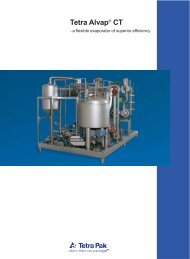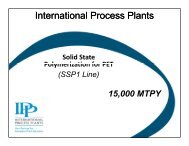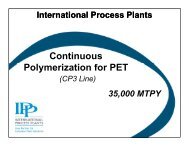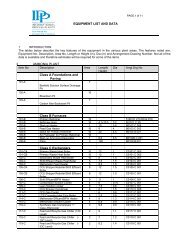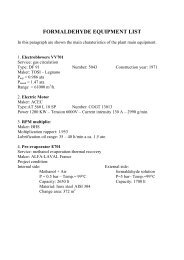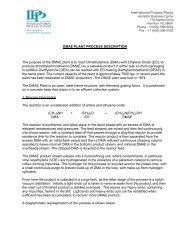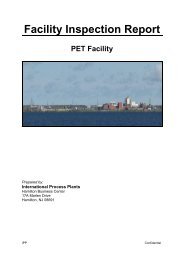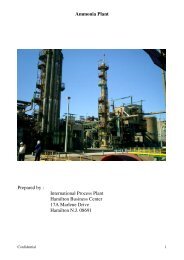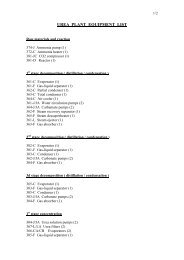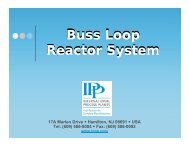Design of an integrated melamine-urea process - ippe.com
Design of an integrated melamine-urea process - ippe.com
Design of an integrated melamine-urea process - ippe.com
Create successful ePaper yourself
Turn your PDF publications into a flip-book with our unique Google optimized e-Paper software.
4. NEW INTEGRATED UREA-MELAMINE PROCESSThe main goal <strong>of</strong> the development <strong>of</strong> <strong>an</strong> <strong>integrated</strong> <strong>urea</strong>-<strong>melamine</strong> <strong>process</strong> is the reduction<strong>of</strong> the energy <strong>an</strong>d capital costs <strong>of</strong> the <strong>process</strong>. The main improvements <strong>com</strong>pared with theconventional gas-phase <strong>melamine</strong> <strong>process</strong> are:o heat recovery from the byproducts ammonia <strong>an</strong>d carbon dioxideo export <strong>of</strong> water-free byproduct gases to the <strong>urea</strong> pl<strong>an</strong>t without a concentration unito synthesis <strong>of</strong> <strong>melamine</strong> melt instead <strong>of</strong> <strong>melamine</strong> vaporo <strong>integrated</strong> purification <strong>of</strong> the <strong>melamine</strong> melt without a recrystallization unito water-free quench <strong>process</strong> producing directly dry powdero low cost ammonia recovery due to separation <strong>of</strong> byproduct gas before the quenchA block scheme <strong>of</strong> the <strong>integrated</strong> <strong>urea</strong>-<strong>melamine</strong> <strong>process</strong> is shown in figure 5. The <strong>process</strong> isoperated at high pressure (150 – 250 bar) in order to produce <strong>melamine</strong> melt instead <strong>of</strong><strong>melamine</strong> vapor. Urea melt <strong>com</strong>ing from the <strong>urea</strong> pl<strong>an</strong>t is preheated in the direct contactor by thehot (360 – 440 ° C) byproduct gases ammonia <strong>an</strong>d carbon dioxide, which were produced in thereactor. This <strong>of</strong>f-gas is simult<strong>an</strong>eously cooled to temperatures below 250 ° C <strong>an</strong>d steam isproduced in the contactor. In this way heat from the byproduct gases is recovered <strong>an</strong>d c<strong>an</strong> beused in the <strong>process</strong> for preheating <strong>process</strong> streams or equipment. In the reactor the preheated<strong>urea</strong> is converted into a <strong>melamine</strong> melt <strong>an</strong>d ammonia <strong>an</strong>d carbon dioxide gas using HeatTr<strong>an</strong>sfer Salt (HTS) as a heating medium. In the separator the <strong>melamine</strong> melt <strong>an</strong>d the gases areseparated creating theNH 3 + CO 2 toUrea Steam <strong>urea</strong> pl<strong>an</strong>tContactorAmmoniaRecoveryReactor Separator Quench Melamine<strong>urea</strong> NH 3 +CO 2NH 3HTS NH 3Figure 5. Block diagram <strong>of</strong> the <strong>integrated</strong> high-pressure <strong>melamine</strong> <strong>process</strong>. The bold lines showthe heat flows; the thin lines show the <strong>process</strong> flows.capability to recover heat from the byproduct gas in the contactor. The <strong>melamine</strong> melt is purifiedin the separator by addition <strong>of</strong> ammonia gas. The hot ammonia gas used for the purification stepis also sent to the contactor for heat recovery. The purification occurs direclty in the melt <strong>an</strong>d noseparate recrystallization step is required. Then the melt is sprayed <strong>an</strong>d quenched with theevaporating liquid ammonia in the quench section. The amount <strong>of</strong> liquid ammonia is just enoughto cool the <strong>melamine</strong> to the required temperature <strong>an</strong>d all ammonia is evaporated. Dry <strong>melamine</strong>powder <strong>of</strong> high quality is obtained directly without a drying step. The evaporated ammonia fromthe quench is condensed in the ammonia recovery section <strong>an</strong>d is re-used. The ammonia recoveryis much simpler th<strong>an</strong> in the gas-phase <strong>process</strong>, since the byproduct gas has been separatedbefore the quench.2
An extra adv<strong>an</strong>tage <strong>of</strong> the new <strong>melamine</strong> <strong>process</strong> is that the <strong>of</strong>f-gas <strong>com</strong>ing from thecontactor is water-free <strong>an</strong>d c<strong>an</strong> be recycled directly to the <strong>urea</strong> pl<strong>an</strong>t without a concentration unit<strong>an</strong>d without a negative impact on the <strong>urea</strong> conversion. If the <strong>melamine</strong> <strong>process</strong> is operated at apressure higher th<strong>an</strong> the pressure <strong>of</strong> the <strong>urea</strong> pl<strong>an</strong>t a direct coupling (Meessen et al. [9] <strong>an</strong>d v<strong>an</strong>Wijck [10]) with the high-pressure section in a <strong>urea</strong> pl<strong>an</strong>t without condensation <strong>of</strong> the gases isfeasible. This results in a fully <strong>integrated</strong> <strong>urea</strong>-<strong>melamine</strong> <strong>process</strong>.Utilities (per metric ton <strong>of</strong> <strong>melamine</strong>):Natural gas:7 GJ (reactor)Steam:< 1 tonElectricity:< 0.4 MWhCooling water: < 400 tonTable 3. Utilities consumption <strong>of</strong> New Integrated Melamine <strong>process</strong>Safety precautions are <strong>an</strong> import<strong>an</strong>t issue during design <strong>an</strong>d operation because <strong>of</strong> the highpressure <strong>an</strong>d temperature. During start-up <strong>an</strong>d shut-down the <strong>process</strong> is operated at reducedpressure to minimize risks in case <strong>of</strong> a <strong>process</strong> failure. The direct coupling requires asophisticated automatic pressure control system.Although the high-pressure section is expensive the total capital cost <strong>of</strong> the new <strong>process</strong> islower <strong>com</strong>pared to the conventional <strong>process</strong>. The <strong>integrated</strong> high-pressure <strong>melamine</strong> <strong>process</strong>requires only 40% <strong>of</strong> the energy consumption <strong>of</strong> a conventional gas-phase <strong>melamine</strong> <strong>process</strong><strong>an</strong>d has no negative impact on the <strong>urea</strong> conversion <strong>an</strong>d stripping in the <strong>urea</strong> <strong>process</strong>. Moredetailed information on the utility consumption <strong>of</strong> the new <strong>integrated</strong> <strong>melamine</strong> <strong>process</strong> in givenin Table 3.5. SUMMARYThe main improvements <strong>of</strong> newly developed <strong>integrated</strong> <strong>urea</strong>-<strong>melamine</strong> <strong>process</strong> <strong>com</strong>paredwith the conventional gas-phase <strong>melamine</strong> <strong>process</strong> are:o heat recovery from the byproducts ammonia <strong>an</strong>d carbon dioxideo export <strong>of</strong> water-free byproduct gases to the <strong>urea</strong> pl<strong>an</strong>t without a concentration unito synthesis <strong>of</strong> <strong>melamine</strong> melt instead <strong>of</strong> <strong>melamine</strong> vaporo <strong>integrated</strong> purification <strong>of</strong> the <strong>melamine</strong> melt without a recrystallization unito water-free quench <strong>process</strong> producing directly dry powdero low cost ammonia recovery due to separation <strong>of</strong> byproduct gas before the quenchAs a result <strong>of</strong> this the <strong>integrated</strong> high-pressure <strong>melamine</strong> <strong>process</strong> has lower investment costs<strong>an</strong>d requires only 40% <strong>of</strong> the energy consumption <strong>of</strong> a conventional gas-phase <strong>melamine</strong><strong>process</strong>. In addition the new <strong>melamine</strong> <strong>process</strong> produces high quality <strong>melamine</strong>.3




